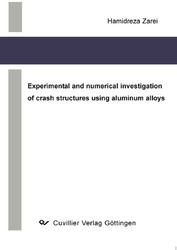| Areas | |
|---|---|
| Serie de libros (96) |
1378
|
| Nachhaltigkeit |
3
|
| Gesundheitswesen |
1
|
| Letra |
2363
|
| Ciencias Naturales |
5406
|
| Ciencias Ingeniería |
1791
|
| Ingeniería | 292 |
| Ingeniería mecánica y de proceso | 861 |
| Ingeniería eléctrica | 686 |
| Mineria y metalurgía | 30 |
| Arquitectura e ingeniería civil | 75 |
| General |
98
|
|
Leitlinien Unfallchirurgie
5. Auflage bestellen |
|
Erweiterte Suche
Experimental and numerical investigation of crash structures using aluminum alloys (Tienda española)
Hamidreza Zarei (Autor)Previo
Indice, Datei (27 KB)
Lectura de prueba, Datei (76 KB)
Concerns have been raised for many years about the quality and safety of the vehicles as well as their contribution to the air pollution that endangers public health. Several vehicle safety standards have been developed for different crash scenarios. To improve air quality and reduce vehicle’s emissions, there are high interests to amend vehicle fuel consumption through producing light weight vehicles. These improvements should not menace vehicle safety. Vehicle designers achieve safety and fuel economy advances through using lightweight materials like aluminum alloys, high strength steels, tailored beams and composite materials in the vehicle’s structures.
In this research, finite element crash simulation of a vehicle model is considered to characterize the energy absorption capacity of the vehicle’s frontal structure. Crashworthiness optimization technique is implemented to reduce the weight of selected frontal elements while vehicle safety performance is improved. Crush performance of the two most effective vehicle’s frontal crash elements, namely, crash box and bumper beam is investigated by a comprehensive experimental and numerical study in axial, oblique and bending crush conditions. The energy absorption mechanisms of these elements are characterized briefly and multi design optimization MDO technique is implemented to maximize their energy absorptions and reduce their weights. The crush behavior of low density materials like aluminum honeycomb and foam is studied. The concept of filling crash box and bumper beam with these materials is investigated experimentally and numerically. The same MDO procedure which is used for empty aluminum crash box is implemented to maximize the energy absorption capacities of the filled structures and minimizing their weights. Experimental and numerical research is performed to investigate the crush behavior of thermoplastic composite crash boxes. The energy absorption mechanisms of composite materials and its differences to aluminum alloys are studied. The effort is conducted to characterize the energy absorption of the foam-filled composite crash box. The MDO procedure is used to maximize energy absorption capacity of the composite crash box and minimize its weight. Finally the optimum composite crash box is compared with the optimum aluminum crash box. In the above mentioned optimization procedures, practical and safety requirements are considered as optimization constraints.
The theoretical methods of predicting the crush behavior of empty and filled crash box and bumper beam are sammaried. The experimental results are used to calibrate these formulations. The calibrated expressions can be used in the primary phase of the vehicle’s structural design.
| ISBN-10 (Impresion) | 3867275424 |
| ISBN-13 (Impresion) | 9783867275422 |
| ISBN-13 (E-Book) | 9783736925427 |
| Idioma | Inglés |
| Numero de paginas | 128 |
| Edicion | 1 |
| Volumen | 0 |
| Lugar de publicacion | Göttingen |
| Lugar de la disertacion | Hannover |
| Fecha de publicacion | 10.03.2008 |
| Clasificacion simple | Tesis doctoral |
| Area |
Ingeniería mecánica y de proceso
|








